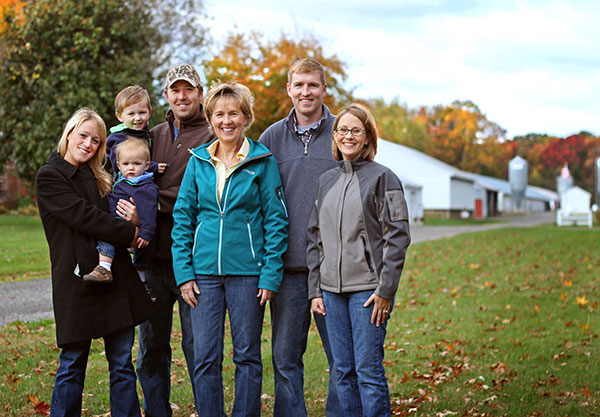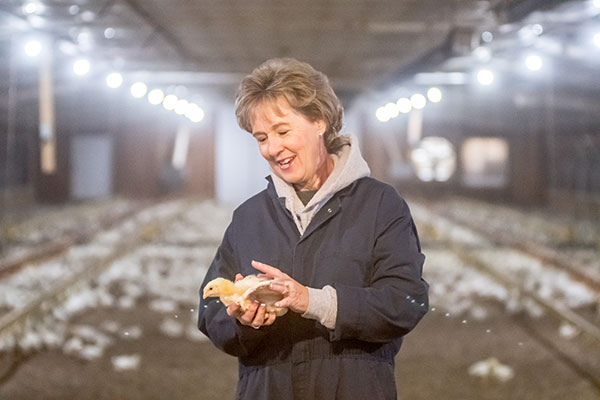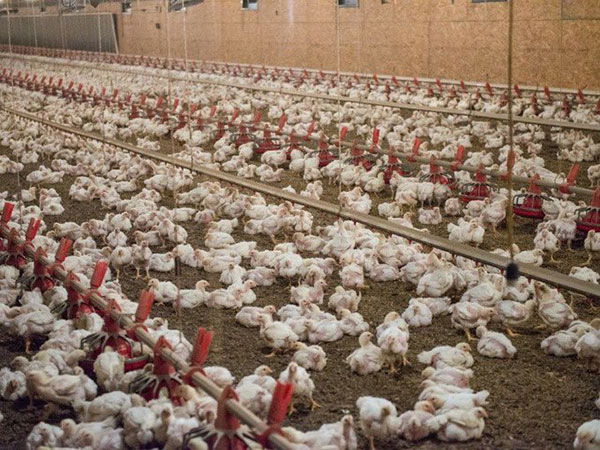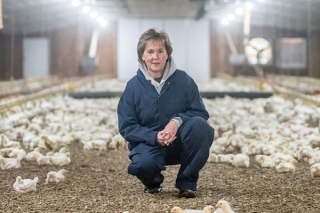 Turn down the lane to Jenny Rhodes’ poultry farm in rural Centerville, Md., and one will see flowers, gardens, bushes, tire swing, a house with a big porch for family gatherings and four white and red barns. It’s an 11-and-a-half-acre property with three stocked ponds, in case the grandchildren want to fish, and four poultry houses that can hold up to 20,000 chickens each. There’s also a manure house. “It feels good looking at my farm,” said the 11th generation farmer who has owned the property for 32 years.
Turn down the lane to Jenny Rhodes’ poultry farm in rural Centerville, Md., and one will see flowers, gardens, bushes, tire swing, a house with a big porch for family gatherings and four white and red barns. It’s an 11-and-a-half-acre property with three stocked ponds, in case the grandchildren want to fish, and four poultry houses that can hold up to 20,000 chickens each. There’s also a manure house. “It feels good looking at my farm,” said the 11th generation farmer who has owned the property for 32 years.
Deerfield Farm grows chickens from merely hours old until they reach the ripe age of 37 days. During a chickens’ life with Rhodes, their every need is carefully attended to from either a heated or cooled house, clean water, fans blowing air, corn and soybean food, lights turned out at night for rest time, and space to roam. “When you look in my barn you see a sea of birds,” Rhodes noted.
“You know the saying, ‘Birds of a feather flock together?’ Well, it’s true,” she explained. Her birds huddle together in groups on the Poultry Litter covered floor, which is a combination of wood shavings and manure. “The worst thing you can do is have one chicken. It would get lonely,” she explained. Rhodes’ chickens are free to move the length of the barn.
 Her birds will grow from a few ounces to five pounds in a little over a month. At four barns with 20,000 chickens in each, that’s 80,0000 birds cared for in a flock. After the birds leave, the houses are cleaned and readied for the next flock. In a good year, Rhodes can raise seven flocks or approximately half a million chickens yearly. “I could feed chicken to about 42,000 people per year. That’s about all the people in Queen Anne’s County (the country where she farms). I am proud of what I do,” she said.
Her birds will grow from a few ounces to five pounds in a little over a month. At four barns with 20,000 chickens in each, that’s 80,0000 birds cared for in a flock. After the birds leave, the houses are cleaned and readied for the next flock. In a good year, Rhodes can raise seven flocks or approximately half a million chickens yearly. “I could feed chicken to about 42,000 people per year. That’s about all the people in Queen Anne’s County (the country where she farms). I am proud of what I do,” she said.
From the outside, the poultry houses might look like just a barn, but inside technology drives the farming business. Computer systems monitor the internal barn temperature, feed, water, and delivery systems. That information is fed to Rhodes’ phone, laptop, computer, and iPad. She can quickly make changes to any systems and can also tell just as quickly if something is not working correctly. Technology has changed poultry farming through the years and made it more efficient.
Another aspect of technological advances comes in the form of environmental stewardship. As technology has increased, Rhodes has adopted those changes into her farming practice. For instance, she installed LED lights, the fans that circulate air are more energy efficient and she has changed her heating source to radiant tube heat, which means she uses 1,000 gallons of propane gas when she used to go through 9,000 gallons.
Not all poultry farming changes have come through technology, though. Some modifications have occurred because of science. Back when Rhodes purchased her farm, chicken manure sat outside in a big pile where runoff could be a problem. Soon after buying the farm, Rhodes built the manure house which both keeps the Poultry Litter under a roof and out of the weather, but now she recycles it into organic slow-release plant food for farmers to fertilize their crops. “We recycle everything, and nothing gets wasted,” Rhodes explained.
 Once a flock leaves, the Poultry Litter is composted in the manure house. The temperature is raised to 130 degrees to kill bacteria and any disease. The temperature is then reduced and the pile stirred and flipped. This process occurs three times to create plant food ready to be used on the farming fields. “The birds eat corn and soybeans grown by a farmer. Then, they poop it out and it gets recycled to go onto the fields that grow corn and soybeans again,” Rhodes said.
Once a flock leaves, the Poultry Litter is composted in the manure house. The temperature is raised to 130 degrees to kill bacteria and any disease. The temperature is then reduced and the pile stirred and flipped. This process occurs three times to create plant food ready to be used on the farming fields. “The birds eat corn and soybeans grown by a farmer. Then, they poop it out and it gets recycled to go onto the fields that grow corn and soybeans again,” Rhodes said.
 Another large change in the poultry industry is the size of the birds. Although Rhodes’ birds are about five pounds, the size of a roaster chicken, many other farms produce larger birds. “Their birds aren’t bigger because of hormones and steroids. It’s because they were bred that way,” she explained. “If chickens were given steroids, you have to give them a shot every day.”
Another large change in the poultry industry is the size of the birds. Although Rhodes’ birds are about five pounds, the size of a roaster chicken, many other farms produce larger birds. “Their birds aren’t bigger because of hormones and steroids. It’s because they were bred that way,” she explained. “If chickens were given steroids, you have to give them a shot every day.”
The Rhodes family has passed down their love of farming from generation to generation. Jenny Rhodes is an 11th generation farmer and her two sons are the 12th Rhodes farming generation. Her father is 79 years old and still farms today. He taught her and her four siblings to work together but understand everyone needs their own entity or farm. Since her dad was a grain farmer, when Rhodes decided farming would be life too she looked into following his footsteps and investigated grain farming. However, she decided it wouldn’t pay for itself and that’s when she discovered the business aspects of poultry farming. Some farmers are part of an integrated system where a farmer works with a producer and agrees to produce a certain number of chickens and enters into a contract for a specific chicken price. That contract can then be taken to a bank for a loan, if needed. Rhodes is part of an integrated system with producer Allen Harin, located in Delaware.
During her 32 years in the poultry business, she has learned not only from her family but also from other farmers. “Farmers are good about sharing what works for them,” she said. She also employed her dad’s farming philosophy of owning your own farm when raising her two sons. After they graduated from college, each was able to begin a poultry farm of their own. “We farmers learn from each other,” she said.
Rhodes is proud of her farming practice and heritage. “I am always striving to make things better for the environment, ourselves and the chickens,” she said. Her hard work is paying off.
Photos courtesy of Edwin Remsberg
